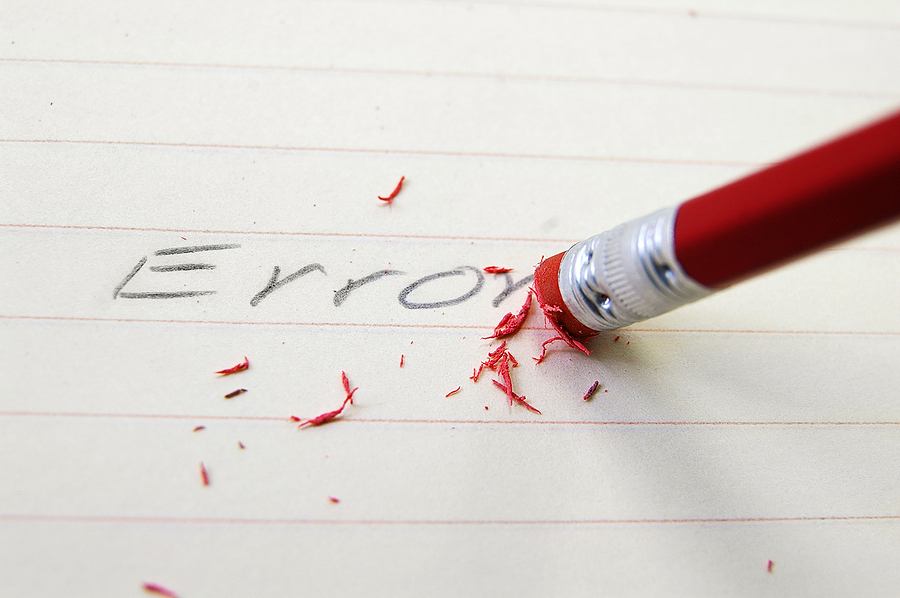From time to time, you may realise that you have made a mistake on a previous activity statement. You may have found extra receipts or purchase invoices or you may have forgotten about a sales invoice that you raised in the previous period.

You must correct these mistakes but how do you do this? The ATO website has quite a long and rather wordy explanation of how to remedy your errors but I’ll try to keep it simple here!
The first thing to be aware of is that your annual turnover determines the number of months you can review for GST errors. The following table from the ATO website explains these restrictions:
| Annual turnover | Time limit |
| Less than $20m | Up to 18 months (18 monthly activity statements, 6 quarterly activity statements or one annual GST return). |
| $20m to less than $100m | Up to three months (three monthly activity statements) |
| $100m to less than $500m | Up to three months (three monthly activity statements) |
| $500m to less than $1b | Up to three months (three monthly activity statements) |
| $1b and over | Up to three months (three monthly activity statements) |
So basically, if your business turnover is less than $20 million and the transactions occurred within 18 months of the end of the current BAS period, you can include an adjustment in the current BAS. Another thing to remember is that the errors and omissions must not be more than $5,000.00 in GST credits.
If your turnover is more than $20 million, see the table below from the ATO:
| Annual turnover | Correction limits |
| Less than $20m | Less than $5,000 |
| $20m to less than $100m | Less than $10,000 |
| $100m to less than $500m | Less than $25,000 |
| $500m to less than $1b | Less than $50,000 |
| $1b and over | Less than $300,000 |
So what if none of these restrictions applies to your situation? What if the time limits are longer and the GST credits are more than $5,000.00? Well you can still do something. You will have “revise” each of the BAS that are in error. Unfortunately, the ATO may charge you general interest fees in this case. For more information from the ATO about this issue see Revising an earlier activity statement
Okay so back to our question – how do you correct your BAS mistakes? Let’s take this in two parts: claiming too much GST and not claiming enough GST.
Claiming Too Much GST
How do you claim too much GST on your BAS? The following may have occurred:
- You forgot to include a sales invoice
- You coded a sale as GST Free when in fact it included GST
- You made an error in coding your transactions (see our blog “Common GST Mistakes”)
- You included a purchase that isn’t actually tax deductible
- You included 100% of a purchase that wasn’t for 100% business-use
Correcting mistakes that increase the amount of GST to be paid are known as “increasing adjustments”.
Not Claiming Enough GST
Sometimes, you might not claim enough GST on your BAS. In this case the ATO has imposed a 4 year time limit for the claiming of refunds. This means that you can only claim for mistakes that were made up to 4 years since the end of the tax period when the mistake/s were made. See this ATO publication for more information on the 4 year limit Time limits on GST refunds (NAT 11645).
Some situations in which this might happen are:
- You found some purchase receipts or invoices from previous periods after you lodged the BAS
- You made an error in coding your transactions
- Your accountant advises you that a purchase you made is actually tax deductible but you did not include it in a previous BAS
- You coded a GST Sale as taxable but it was actually GST Free
Correcting mistakes that decrease the amount of GST to be paid are known as “decreasing adjustments”.
Okay so you’ve identified that you’ve made one or more of the above mistakes. How do you correct this them on your BAS? Depending on whether you need to make an increasing or decreasing adjustment, you need to do the following (from the ATO website):
“If you use the accounts method, you simply add or subtract the correction amounts at boxes 1A and/or 1B to adjust the amounts for the current period. You also reflect the corrections in the amounts of sales and purchases (GST-inclusive or GST-exclusive) at boxes G1, G2, G3, G10 or G11 as appropriate”.
An interesting point to note is that you do not make these corrections in boxes G7 or G18 on the calculation sheet because these boxes are reserved for “adjustments” which are defined in GST law.
Hopefully, now you will feel confident to have a go at amending your BAS mistakes. If you are still confused, feel free to give us a call at e-BAS Accounts for advice or make a booking and let us take the stress out of the situation for you and ask us to process your BAS for you.

Hi,
Great explanation for the “increasing and decreasing adjustment” of correcting GST Mistakes.
If you can explain how to Record Journal Entry as well for this Mistakes, for example in MYOB, that will be perfected.
Kind regards,